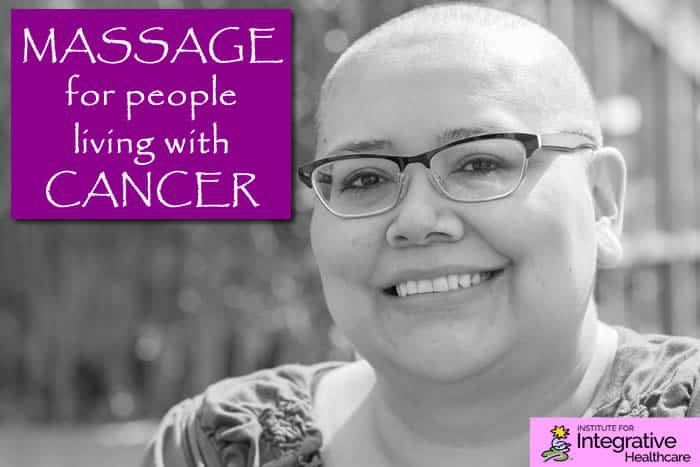

Oncology Massage
Oncology massage is a particular form of massage therapy that is customized to meet the needs of a person who is currently going through cancer treatment, or has a cancer history. It is important for a massage therapist who wants to work with cancer patients to have specialized training in cancer care. The massage needs to be client specific and must consider all of the possible short and long-term side effects of treatment. Massage therapists who give oncology massage sessions must have a comprehensive understanding of their client’s cancer history and current course of treatment, in order to take proper precautions and consider the modifications needed for a safe, effective massage.
Combating the Side Effects
Cancer can take patients on a long journey. Often, a course of treatment may last months or years from beginning to end and it is both physically and emotionally challenging. With the course of treatment comes a myriad of side effects. When treatment finishes, the patient is also left with recovering from the consequences of cancer medications, possible surgery, and a roller coaster of emotions. Massage therapy is effective at tackling everything from the more general side effects of cancer, to the specific post-treatment (i.e. radiation, chemotherapy, or surgery) outcomes.
8 Benefits of Massage for General Side Effects
- Anxiety – Massage reduces anxiety in advance of surgery or other forms of treatment. Oncology massage sessions provide positive touch that puts patients at ease.
- Stress – Patients receiving oncology massage report reduced stress in advance of or following treatment. Short, gentle massage sessions activate the parasympathetic nervous system, which lowers cortisol levels, relieves stress, and gives a sense of overall wellbeing.
- Insomnia – Regular massage sessions relax the body and mind, decreasing pain and, for some patients, ultimately preventing insomnia.
- Constipation – When the body relaxes, the digestive system works more effectively and efficiently. If the body is relaxed, there is a decrease in pain, and less need for pain medications that can cause constipation. Specific abdominal massage techniques also help to ease constipation.
- Nausea – Massage is reportedly a “pleasant distraction” that can help reduce nausea caused by nervousness, anxiety, or chemotherapy treatments. With less nausea, patients have increased nutritional intake and less weight loss.
- Pain – Massage helps decrease pain. Oncology massage is effective at decreasing post-surgical pain and lessens the need for pain reducing medications.
- Depression – As patients journey through their disease processes, they feel hopeful and more positive after receiving massage. Patients report that massage feels satisfying, amazing, and decreases stress and pain. Oncology massage is a way for patients to feel more present in their recovery process. The massage sessions keep their spirits up, so they can focus on healing.
- Fatigue – Oncology massage increases alertness and mental clarity in patients. When patients receive massage following treatment, they report a reduction in fatigue, so they can move about their day without always feeling tired.
4 Benefits of Massage Following Radiation or Chemotherapy
- Anxiety – During the course of treatment, cancer patients experience tremendous anxiety as they navigate difficult, medical procedures. Patient who receive massage sessions experience less anxiety in advance of and during treatment.
- Fatigue – After treatment, massage can help reduce fatigue and give the patient more energy.
- Loss of Appetite or Nausea – Overall, patients report improvement in their appetite and less nausea.
- Peripheral Neuropathy – Peripheral neuropathy results in the numbness and loss of sensation in the hands and feet, and is sometimes a side effect of cancer treatment. Oncology massage helps stimulate the nervous system and reduce the effects of peripheral neuropathy.
4 Benefits of Massage Following Surgery
- Anesthesia – Following surgery for cancer, massage makes recovering from anesthesia easier.
- Lymphedema – Cancer surgery that involves the removal of lymph nodes may cause lymphedema, or a buildup of fluids in the tissues that leads to swelling. Specific lymphatic drainage massage techniques, given by a highly-trained therapist, will reduce swelling for the patient.
- Scarring – Massage is effective at improving mobility and decreasing the appearance and adhesions that are part of surgical scars.
- Joint Mobility – Oncology massage therapists may implement soft tissue manipulation techniques and join movements to help improved range of motion or support easier adaptation to implants and expanders.
Considerations
Oncology massage has wide reaching benefits to cancer patients. In order to provide the best possible care, massage therapists should follow these considerations.
- Ask for a doctor’s note. This not required, but it is best to have a doctor’s formal recommendation for oncology massage if possible. A recommendation for massage has many benefits. In particular, the note opens up a conversation between the doctor, patient and therapist, and overall improves the coordination and the quality of the patient’s care.
- Cancer is different for everybody. Develop an understanding of the type of cancer your client is living with – including the side effects, contraindications, and modifications necessary when giving massage.
- Complete a well-rounded, thorough intake that educates you about your client and their specific needs and wants. This may include input from their doctor in some cases.
- All of the above will influence your speed, duration and level of pressure. Be prepared to change and modify your session due to the ever-changing nature of the cancer experience.
Oncology massage is an evidence-based treatment modality for coping with the side effects of cancer. Highly-trained massage therapists are able to meet the needs of cancer patients and support them in their cancer journey. Today’s research supports the use of massage for confronting the pain and suffering that often accompanies a cancer diagnosis.











